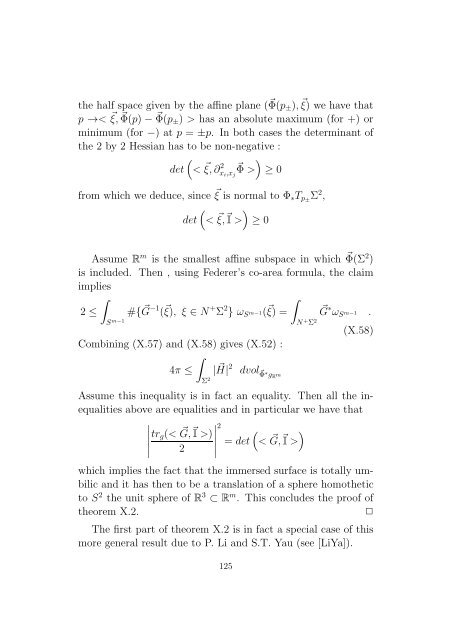Conformally Invariant Variational Problems. - SAM
Conformally Invariant Variational Problems. - SAM
Conformally Invariant Variational Problems. - SAM
Create successful ePaper yourself
Turn your PDF publications into a flip-book with our unique Google optimized e-Paper software.
the half space given by the affine plane ( Φ(p ⃗ ± ), ξ) ⃗ we have that<br />
p →< ξ, ⃗ Φ(p)− ⃗ Φ(p ⃗ ± ) > has an absolute maximum (for +) or<br />
minimum (for −) at p = ±p. In both cases the determinant of<br />
the 2 by 2 Hessian has to be non-negative :<br />
det<br />
(< ξ,∂ ⃗ )<br />
x 2 ⃗<br />
i ,x jΦ > ≥ 0<br />
from which we deduce, since ξ ⃗ is normal to Φ ∗ T p± Σ 2 ,<br />
(<br />
det < ξ, ⃗ ⃗ )<br />
I > ≥ 0<br />
Assume R m is the smallest affine subspace in which Φ(Σ ⃗ 2 )<br />
is included. Then , using Federer’s co-area formula, the claim<br />
implies<br />
∫<br />
∫<br />
2 ≤ #{ G ⃗−1 ( ξ), ⃗ ξ ∈ N + Σ 2 } ω S<br />
m−1( ξ) ⃗ = G ⃗ ∗ ω S<br />
m−1 .<br />
S m−1 N + Σ 2 (X.58)<br />
Combining (X.57) and (X.58) gives (X.52) :<br />
∫<br />
4π ≤ | H| ⃗ 2 dvol ⃗Φ∗ g R<br />
Σ 2 m<br />
Assume this inequality is in fact an equality. Then all the inequalities<br />
above are equalities and in particular we have that<br />
tr g (< G, ⃗ ⃗ I >)<br />
2<br />
(<br />
= det < G,<br />
∣ 2 ∣<br />
⃗ ⃗ )<br />
I ><br />
which implies the fact that the immersed surface is totally umbilic<br />
and it has then to be a translation of a sphere homothetic<br />
to S 2 the unit sphere of R 3 ⊂ R m . This concludes the proof of<br />
theorem X.2.<br />
✷<br />
The first part of theorem X.2 is in fact a special case of this<br />
more general result due to P. Li and S.T. Yau (see [LiYa]).<br />
125
















